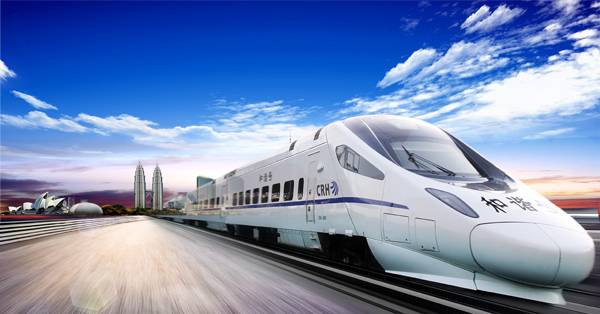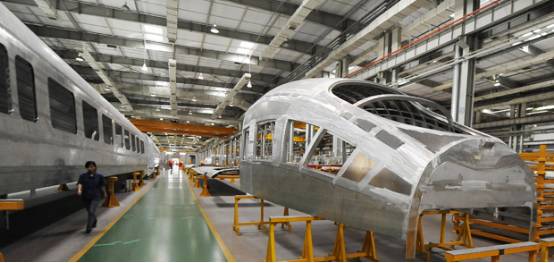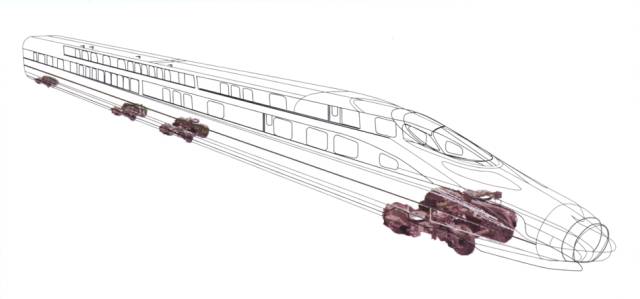Application of composite materials in high-speed railways
High-speed railway trains have become an important way for industrialized countries to alleviate road, water transport and air traffic congestion. The world, including China, Many countries have regarded the development of high-speed trains as an important goal for future train development. Today, high speed, safety and comfort have become the focus of the development of high-speed railway technology. Reducing the weight of EMU vehicles and increasing the speed of EMUs are the goals of the development of the railway industry.

Harmony
The application of composite materials on trains can be roughly divided into Two categories: composite material non-main load-bearing parts and composite material main load-bearing parts. Among them, non-main load-bearing parts of composite materials can be divided into main load-bearing parts (such as non-main load-bearing parts such as car bodies, floors, and seats) and auxiliary parts (auxiliary components such as washrooms, toilets, and water tanks). Load-bearing parts mainly refer to large load-bearing components of trains such as train bodies, driver’s cabs, and bogie frames. They are the key to replacing traditional materials with composite materials and achieving lightweight vehicles.
1. Application of composite materials in train auxiliary parts and general load-bearing parts
In the high-speed passenger cars used by Japan’s Shinkansen, glass fiber reinforced plastic (GFRP) composite materials are mainly Used in window interior frames, washrooms, toilets, urinals, water tanks, toilets, front covers, roof panels at both ends of double-decker buses, ceilings of air-conditioning ducts, and side ceilings of air-conditioning covers of dining cars, etc. parts. In order to reduce aerodynamic noise around the pantograph, the pantograph cover installed on the roof is also made of GFRP material. The 200 series Tohoku and Joetsu Shinkansen buses use honeycomb sandwich materials to make floors, middle partition doors, etc.
Similarly, French TGV high-speed trains also use fiber-reinforced plastic (FRP) to make floors, wall panels, door and window frames, seats and doors. In addition to being light in weight, using FRP to manufacture these components also has the advantages of easy design, reduced maintenance work, and the possibility of using integral molding to reduce costs. In addition, toilets with fiberglass floors and integrated toilets have become more popular abroad, which not only solves the corrosion problem but also achieves the purpose of reducing weight.
On the Italian ETR500 high-speed train, all internal structural side walls, ceilings and luggage compartments use high-specific stiffness composite sandwich panels – Nomex sandwiched between two thin layers of Tedlar polyvinyl fluoride plastic. Honeycomb core material fiberglass phenolic laminate; Eurostar trains also use phenolic honeycomb panels as their internal structural parts.
After testing, the British railway department found that the performance of aramid fiber reinforced composite materials as the pantograph head was very satisfactory. In recent years, composite materials have also been used as impact-resistant components and have achieved good test results.
2. Composite materials for manufacturing train main load-bearing parts
At present, fiber-reinforced composite materials are increasingly used in load-bearing structural parts, and their technology is basically close to practical application. . As the large load-bearing components of the train, the train cab, car body and bogie frame account for a large proportion of the vehicle’s structural weight. The car body’s self-weight accounts for 15% to 35% of the vehicle’s self-weight, and the bogie accounts for 15% of the vehicle’s self-weight. 25%~35%. Therefore, these parts are the main research areas for the application of new materials.
(1) Driver’s cab of a high-speed train. The front-end shape needs to be made into a nose shape, which is both lightweight and impact-resistant. FRP has been widely used here. The front end of the British City 125 locomotive cab is made of laminated FRP boards covered with polyurethane foam core to form a sandwich structure. It is 30% to 35% lighter than steel parts and can withstand a 0.9Kg heavy square steel block moving at 300Km/ h speed impact; the head of the Italian ETR500 high-speed power train is molded with Kevlar fiber and epoxy resin, which has good rigidity and impact resistance. The maximum speed of the train can reach 300Km/h.
High-speed train driver’s cab

(2 ) composite roof. The application of composite materials on the roof cover can lower the center of gravity of the vehicle and increase the stability of the vehicle body. The Japan Railway Institute of Technology cooperates with East Japan Passenger Railway Company to make high-speed train roofs from carbon fiber reinforced plastic (CFRP). The CFRP roof is connected to the aluminum alloy frame through gluing, and then welded to the aluminum alloy body. The alloy side walls are joined together. Tests show that the car body using this kind of roof has higher airtight strength and lower center of gravity, and each car is lighter by about 300~500Kg
(3) Composite material car body. The car body is divided into two types according to different processes:
1. Integrate the 2.1mm thick curved plate and the longitudinal beam, rivet the pultruded CFRP outer plate to the aluminum alloy frame, and trial-produce the car body The length is 6000mm, the width is 3300mm, the height is 3290mm, and the weight is 680Kg.
2. Two semi-circular car bodies with a length of 1000mm, a width of 3320mm and a height of 3300mm are made by hot pressing and then riveted to each other. Compared with the aluminum alloy car body, the weight is reduced by 30%. Moreover, phenolic-based CFRP has better high-temperature resistance than aluminum alloy. Aluminum alloy will produce large deflection deformation under the stress of 400°C and 40MPa, while phenolic-based CFRP has very small stress deformation at 500°C and 130MPa.
Car body 3D

(4) Composite materials Bogie. The bogie of a rolling stock is an important component that supports the car body and ensures the smooth operation of the train. Its structure is a large load-bearing component with particularly high requirements for strength and fatigue resistance. The German AEG and MBB companies are working under the Federal Ministry of Research and Technology. With the support, the world’s first composite bogie was developed, model HLD-E, with a design speed of 200Km/h. Following Germany, Japan also successfully trial-produced a CFRP bogie frame, with a dead weight of 0.3t, which is higher than ordinary The steel frame is reduced by 70%. The frame beam is a CFRP laminated material laminated structure with a plate thickness of 16.4mm. The beam is wound and formed with a maximum design speed of 160Km/h.
High-speed train bogie






